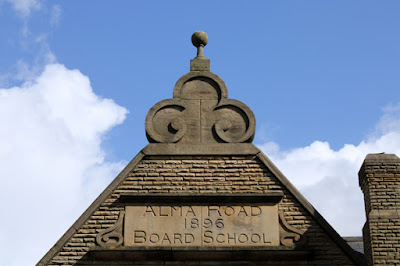 |
| A detail of the Alma Road Board School in Rotherham |
Since visiting my first Sheffield Board School in Walkley, in the last week of February 2021, I had visited more than 20 others in a period of less than three months, including those forming the central complex centred on Leopold Street.
Based on the information provided in Building Schools for Sheffield and reinforced by the short article on the Sheffield Area Geology Trust website, as well as my own observations, I think that Crawshaw Sandstone has been used for the walling stone in most of these schools.
At the Leopold Street buildings, however, Crosland Hill sandstone from the Rough Rock near Huddersfield is the principal building stone and, at the Wincobank and Pye Bank board schools, I think that other sandstones have been used.
For my next excursion, on the Sunday after I had briefly surveyed the building stones at Burngreave Cemetery and Christ Church, I decided to investigate the few remaining schools that were commissioned by the Rotherham United School Board - starting at Alma Road.
An internet search has revealed very little about the board schools in Rotherham, but the Local List of Buildings of Architectural or Historic Interest, produced by Rotherham District Civic Society states that Joseph Platts of Rawmarsh designed the extension and caretaker’s house, built in 1907 and probably the original 1896 school too.
The most obvious architectural features of the original school building are the steeply pitched roofs, with gables being ornamented with finials, trefoils, scrolls, kneelers and prominent keystones used for the window arches.
Many of the design elements look similar to those used in the Sheffield Board Schools, which include herringbone masonry set within recessed arches with voussoirs and these are continued in the school extension, with some gables being in the Dutch style.
The vast majority of the historic stone buildings in Rotherham are built in the locally distinctive Rotherham Red sandstone - a variety of the Mexborough Rock – with the walling stone for the remainder typically containing prominent iron staining and Liesegang rings, which is a feature of the stone quarried from most of the Coal Measures in South Yorkshire.
I didn’t study the stonework closely, but the walling stone is not like anything that I have seen in Rotherham and I don’t think that it would look out of place in Sheffield, where Crawshaw Sandstone was favoured – very often with Stoke Hall stone for the dressings.
Joseph Platts was certainly familiar with Stoke Hall stone, which he used in the Masbrough Equitable Pioneers Society Building on Westgate, completed in 1909. Although I have no evidence to support this, it does make me wonder if he was influenced by the choice of materials used for the Sheffield Board Schools.










No comments:
Post a Comment